Preparation, Characterization of Cd(II) Ion-Imprinted Microsphere and Its Selectivity for Template Ion
Abstract
:1. Introduction
2. Materials and Methods
2.1. Reagents
2.2. Apparatus
2.3. Synthesis of Cd(II) Imprinted Polymeric Microsphere
2.3.1. Preparation of Cd(II)–MA/AN Complex
2.3.2. Preparation of Cd-I-MA-co-AN
2.4. Adsorption Experiments
2.4.1. Adsorption and Desorption Properties of Cadmium Ions
2.4.2. Adsorption Selectivity Experiment
3. Results and Discussion
3.1. Characterization Studies
3.1.1. UV–Vis Adsorption Spectra
3.1.2. SEM
3.1.3. FT-IR Spectra
3.2. Adsorption and Desorption Experiments
3.2.1. Effect of pH
3.2.2. Effect of Flow Rate
3.2.3. Effect of Eluent
3.2.4. Adsorption Capacity
3.2.5. Adsorption Isotherm
3.2.6. Adsorption Selectivity Study
3.2.7. Analysis of Real Sample
3.2.8. Reusability Study
3.2.9. Comparative Study
4. Conclusions
Author Contributions
Funding
Institutional Review Board Statement
Informed Consent Statement
Data Availability Statement
Conflicts of Interest
References
- Chi, Z.; Tan, S.; Tan, X.; Zhong, L.; Li, W. The toxicity of cadmium ion (Cd2+) to phycocyanin: An in vitro spectroscopic study. Environ. Sci. Pollut. Res. Int. 2018, 25, 14544–14550. [Google Scholar] [CrossRef]
- Abdel-Halim, S.H.; Shehata, A.M.; El-Shahat, M.F. Removal of cadmium ions from industrial waste water plants around cairo. Bull. Environ. Contam. Toxicol. 2005, 74, 78–85. [Google Scholar] [CrossRef]
- Radha, E.; Gomathi, T.; Sudha, P.N.; Sashikala, S. Cadmium(ii) ion removal from aqueous solution using chitosan oligosaccharide-based blend. Polym. Bull. 2021, 78, 1109–1132. [Google Scholar] [CrossRef]
- Pagán-Rodríguez, D.; O’Keefe, M.; Deyrup, C.; Zervos, P.; Walker, H.; Thaler, A. Cadmium and lead residue control in a hazard analysis and critical control point (haccp) environment. J. Agric. Food Chem. 2007, 55, 1638–1642. [Google Scholar] [CrossRef]
- Ulmanu, M.; Marañón, E.; Fernández, Y.; Castrillón, L.; Anger, I.; Dumitriu, D. Removal of copper and cadmium ions from diluted aqueous solutions by low cost and waste material adsorbents. Water Air Soil Pollut. 2003, 142, 357–373. [Google Scholar] [CrossRef] [Green Version]
- Idrees, N.; Tabassum, B.; Abd Allah, E.F.; Hashem, A.; Sarah, R.; Hashim, M. Groundwater contamination with cadmium concentrations in some west u.P. Regions, India. Saudi. J. Biol. Sci. 2018, 25, 1365–1368. [Google Scholar] [CrossRef]
- Afroze, S.; Sen, T.K. A review on heavy metal ions and dye adsorption from water by agricultural solid waste adsorbents. Water Air Soil Pollut. 2018, 225, 229. [Google Scholar] [CrossRef]
- BelBruno, J.J. Molecularly imprinted polymers. Chem. Rev. 2019, 119, 94–119. [Google Scholar] [CrossRef]
- Bolukbasi, O.S.; Yola, B.B.; Boyacioglu, H.; Yola, M.L. A novel paraoxon imprinted electrochemical sensor based on MoS2NPs@MWCNTs and its application to tap water samples. Food Chem. Toxicol. 2022, 163, 112994. [Google Scholar] [CrossRef]
- Xu, Y.; Huang, T.; Wang, S.; Meng, M.; YaOn, Y. SiO2-coated molecularly imprinted sensor based on Si quantum dots for selective detection of catechol in river water. J. Environ. 2022, 10, 106850. [Google Scholar] [CrossRef]
- Xie, Y.; Wan, J.; Yan, Z.; Wang, Y.; Xiao, T.; Hou, J.; Chen, H. Targeted degradation of sulfamethoxazole in wastewater by molecularly imprinted MOFs in advanced oxidation processes: Degradation pathways and mechanism. Chem. Eng. J. 2022, 429, 132237. [Google Scholar] [CrossRef]
- Chen, J.; Wang, L.; Liu, Y.; Chen, L.; Li, X.; Wang, X.; Zhu, G. Highly selective removal of kitasamycin from the environment by molecularly imprinted polymers: Adsorption performance and mechanism. Colloids Surf. 2021, 625, 126926. [Google Scholar] [CrossRef]
- Huang, K.; Chen, Y.; Zhou, F.; Zhao, X.; Liu, J.; Mei, S.; Zhou, Y.; Jing, T. Integrated ion imprinted polymers-paper composites for selective and sensitive detection of Cd(ii) ions. J. Hazard. Mater. 2017, 333, 137–143. [Google Scholar] [CrossRef]
- Jakavula, S.; Biata, N.R.; Dimpe, K.M.; Pakade, V.E.; Nomngongo, P.N. Multi-ion imprinted polymers (miips) for simultaneous extraction and preconcentration of Sb(iii), Te(iv), Pb(ii) and Cd(ii) ions from drinking water sources. J. Hazard. Mater. 2021, 416, 126175. [Google Scholar] [CrossRef] [PubMed]
- Singh, D.K.; Mishra, S. Synthesis, characterization and removal of Cd(ii) using Cd(ii)-ion imprinted polymer. J. Hazard. Mater. 2009, 164, 1547–1551. [Google Scholar] [CrossRef]
- He, H.-X.; Gan, Q.; Feng, C.-G. An ion-imprinted silica gel polymer prepared by surface imprinting technique combined with aqueous solution polymerization for selective adsorption of Ni(ii) from aqueous solution. Chin. J. Polym. Sci. 2018, 36, 462–471. [Google Scholar] [CrossRef]
- Branger, C.; Meouche, W.; Margaillan, A. Recent advances on ion-imprinted polymers. React. Funct. Polym. 2013, 73, 859–875. [Google Scholar] [CrossRef]
- Park, J.; Dam, H.A.; Kim, D. Selective sorption behavior of metal(ii) ion-imprinted polymethacrylate microspheres synthesized via precipitation polymerization method. Korean J. Chem. Eng. 2015, 32, 967–973. [Google Scholar] [CrossRef]
- Nishide, H.; Tsuchida, E. Selective adsorption of metal ions on poly(4-vinylpyridine) resins in which the ligand chain is immobilized by crosslinking. Makromol. Chem. 1976, 177, 2295–2310. [Google Scholar] [CrossRef]
- Rao, T.P.; Kala, R.; Daniel, S. Metal ion-imprinted polymers—novel materials for selective recognition of inorganics. Anal. Chim. Acta 2006, 578, 105–116. [Google Scholar] [CrossRef]
- Shakerian, F.; Kim, K.-H.; Kwon, E.; Szulejko, J.E.; Kumar, P.; Dadfarnia, S.; Haji Shabani, A.M. Advanced polymeric materials: Synthesis and analytical application of ion imprinted polymers as selective sorbents for solid phase extraction of metal ions. TrAC Trends Anal. Chem. 2016, 83, 55–69. [Google Scholar] [CrossRef]
- Luliński, P.; Kalny, P.; Giebułtowicz, J.; Maciejewska, D.; Wroczyński, P. Synthesis and characterization of cadmium(ii)-imprinted poly(1-allyl-2-thiourea-co-ethylene glycol dimethacrylate) particles for selective separation. Polymer. Bull. 2014, 71, 1727–1741. [Google Scholar] [CrossRef] [Green Version]
- Li, M.; Feng, C.; Li, M.; Zeng, Q.; Gan, Q.; Yang, H. Synthesis and characterization of a surface-grafted Cd(ii) ion-imprinted polymer for selective separation of Cd(ii) ion from aqueous solution. Appl. Surf. Sci. 2015, 332, 463–472. [Google Scholar] [CrossRef]
- Li, L.; Zhu, F.; Lu, Y.; Guan, J. Synthesis, adsorption and selectivity of inverse emulsion Cd(ii) imprinted polymers. Chin. J. Chem. Eng. 2018, 26, 494–500. [Google Scholar] [CrossRef]
- Jiang, Y.; Kim, D. Synthesis and selective sorption behavior of Pt(iv) ion-imprinted polymer particles. Ind. Eng. Chem. Res. 2014, 53, 13340–13347. [Google Scholar] [CrossRef]
- Zhang, X.; Ou, X.; Zhang, J.; Chen, Z.; Liu, C.; Li, H.; Li, X.; Sun, Y.; Chen, Z.; Zhu, J.; et al. Smart ion imprinted polymer for selective adsorption of Ru(III) and simultaneously waste sample being transformed as a catalyst. J. Hazard. Mater. 2021, 417, 126072. [Google Scholar] [CrossRef] [PubMed]
- Xi, Y.; Luo, Y.; Luo, J.; Luo, X. Removal of cadmium(ii) from wastewater using novel cadmium ion-imprinted polymers. J. Chem. Eng. Data 2015, 60, 3253–3261. [Google Scholar] [CrossRef]
- Bajwa, S.Z.; Lieberzeit, P.A. Recognition principle of Cu2+-imprinted polymers—Assessing interactions by combined spectroscopic and mass-sensitive measurements. Sens. Actuators B Chem. 2015, 207, 976–980. [Google Scholar] [CrossRef]
- Fu, J.; Wang, X.; Li, J.; Ding, Y.; Chen, L. Synthesis of multi-ion imprinted polymers based on dithizone chelation for simultaneous removal of Hg2+, Cd2+, Ni2+ and Cu2+ from aqueous solutions. RSC Adv. 2016, 6, 44087–44095. [Google Scholar] [CrossRef] [Green Version]
- Rahangdale, D.; Kumar, A.; Archana, G.; Dhodapkar, R.S. Ion cum molecularly dual imprinted polymer for simultaneous removal of cadmium and salicylic acid. J. Mol. Recognit. 2018, 31, 2630. [Google Scholar] [CrossRef] [Green Version]
- Yolcu, Z.; Çıtlakoğlu, M. Ion Imprinted Polymers Prepared with a Novel Cd(II) Methacrylate Monomer Complex with 1-Vinylimidazole for Selective Removal of Cd(II) Ions. 2021; preprint. [Google Scholar] [CrossRef]
- Shamsipur, M.; Rajabi, H.R.; Pourmortazavi, S.M.; Roushani, M. Ion imprinted polymeric nanoparticles for selective separation and sensitive determination of zinc ions in different matrices. Spectrochim. Acta A Mol. Biomol. Spectrosc. 2014, 117, 24–33. [Google Scholar] [CrossRef] [PubMed]
- Huang, W.; Liu, Y.; Wang, N.; Song, G.; Yin, X.; Zhang, L.; Ni, X.; Xu, W. A sensitive electrochemical sensor based on ion imprinted polymers with gold nanoparticles for high selective detecting Cd (ii) ions in real samples. J. Inorg. Organomet. Polym. Mater. 2021, 31, 2043–2053. [Google Scholar] [CrossRef]
- Darroudi, A.; Arbab Zavar, M.H.; Chamsaz, M.; Zohuri, G.; Ashraf, N. Ion-imprinted polymer mini-column for on-line preconcentration of thallium(iii) and its determination by flame atomic absorption spectrometry. Anal. Methods 2012, 4, 3798–3803. [Google Scholar] [CrossRef]
- Zhu, F.; Li, L.; Li, N.; Liu, W.; Liu, X.; He, S. Selective solid phase extraction and preconcentration of Cd(ii) in the solution using microwave-assisted inverse emulsion-suspension Cd(ii) ion imprinted polymer. Microchem. J. 2021, 164, 106060. [Google Scholar] [CrossRef]
- Chaipuang, A.; Phungpanya, C.; Thongpoon, C.; Watla-iad, K.; Inkaew, P.; Machan, T.; Suwantong, O. Effect of ethylene diamine tetra-acetic acid and functional monomers on the structure and adsorption properties of copper (ii) ion-imprinted polymers. Polym. Adv. Technol. 2021, 32, 3000–3007. [Google Scholar] [CrossRef]
- Singh, D.K.; Mishra, S. Synthesis and characterization of Hg(ii)-ion-imprinted polymer: Kinetic and isotherm studies. Desalination 2010, 257, 177–183. [Google Scholar] [CrossRef]
- de Liss Meza López, F.; Khan, S.; da Silva, M.A.; Anchieta Gomes Neto, J.; Picasso, G.; Sotomayor, M.D.P.T. Systematic study on the synthesis of novel ion-imprinted polymers based on rhodizonate for the highly selective removal of Pb(ii). React. Funct. Polym. 2021, 159, 104805. [Google Scholar] [CrossRef]
- Xie, C.; Huang, X.; Wei, S.; Xiao, C.; Cao, J.; Wang, Z. Novel dual-template magnetic ion imprinted polymer for separation and analysis of Cd2+ and Pb2+ in soil and food. J. Clean. Prod. 2020, 262, 121387. [Google Scholar] [CrossRef]
- do Lago, A.C.; Marchioni, C.; Mendes, T.V.; Wisniewski, C.; Fadini, P.S.; Luccas, P.O. Ion imprinted polymer for preconcentration and determination of ultra-trace cadmium, employing flow injection analysis with thermo spray flame furnace atomic absorption spectrometry. Appl. Spectrosc. 2016, 70, 1842–1850. [Google Scholar] [CrossRef]
- Gomes, A.C.S.A.; Costa, L.C.; Brito, D.C.; França, R.J.; Marques, M.R.C. Development of a new ion-imprinted polymer (iip) with Cd2+ ions based on divinylbenzene copolymers containing amidoxime groups. Poly. Bull. 2019, 77, 1969–1981. [Google Scholar] [CrossRef]
- Miao, Y.; Zhang, H.; Xie, Q.; Chen, N.; Ma, L. Construction and selective removal of cd ion based on diatom-based Cd (ii) ion-imprinted composite adsorbent. Colloids Sur. 2020, 598, 124856. [Google Scholar] [CrossRef]
- Adauto, A.; Khan, S.; Augusto da Silva, M.; Gomes Neto, J.A.; Picasso, G.; Sotomayor, M. Synthesis, characterization and application of a novel ion hybrid imprinted polymer to adsorb Cd(ii) in different samples. Environ. Res. 2020, 187, 109669. [Google Scholar] [CrossRef] [PubMed]
- Huang, L.; Wang, L.; Gong, L.; Xie, Q.; Chen, N. Preparation, characterization and adsorption characteristics of diatom-based Cd(ii) surface ion-imprinted polymer. J. Dispers. Sci. Technol. 2020, 43, 1321–1322. [Google Scholar] [CrossRef]
- Ashouri, N.; Mohammadi, A.; Hajiaghaee, R.; Shekarchi, M.; Khoshayand, M.R. Preparation of a new nanoparticle Cd(ii)-imprinted polymer and its application for selective separation of cadmium(ii) ions from aqueous solutions and determination via inductively coupled plasma optical emission spectrometry. Desalin. Water Treat. 2016, 57, 14280–14289. [Google Scholar] [CrossRef]
- Lu, H.; An, H.; Xie, Z. Ion-imprinted carboxymethyl chitosan-silica hybrid sorbent for extraction of cadmium from water samples. Int. J. Biol. Macromol. 2013, 56, 89–93. [Google Scholar] [CrossRef]
- Shi, Y.Y.; Zhang, Q.H.; Feng, L.D.; Xiong, Q.P. Studies on preparation and adsorption behavior of Cd2+ ions-imprinted polymer. Adv. Mat. Res. 2012, 549, 419–422. [Google Scholar] [CrossRef]
- Ma, R.; Yang, Y.; Zhang, X.; Fu, B.; Li, X.; Huang, L.; Chen, N.; Xie, Q. Preparation and optimization of diatom-based cadmium ion-imprinted materials. J. Mol. Struct. 2022, 1251, 132044. [Google Scholar] [CrossRef]

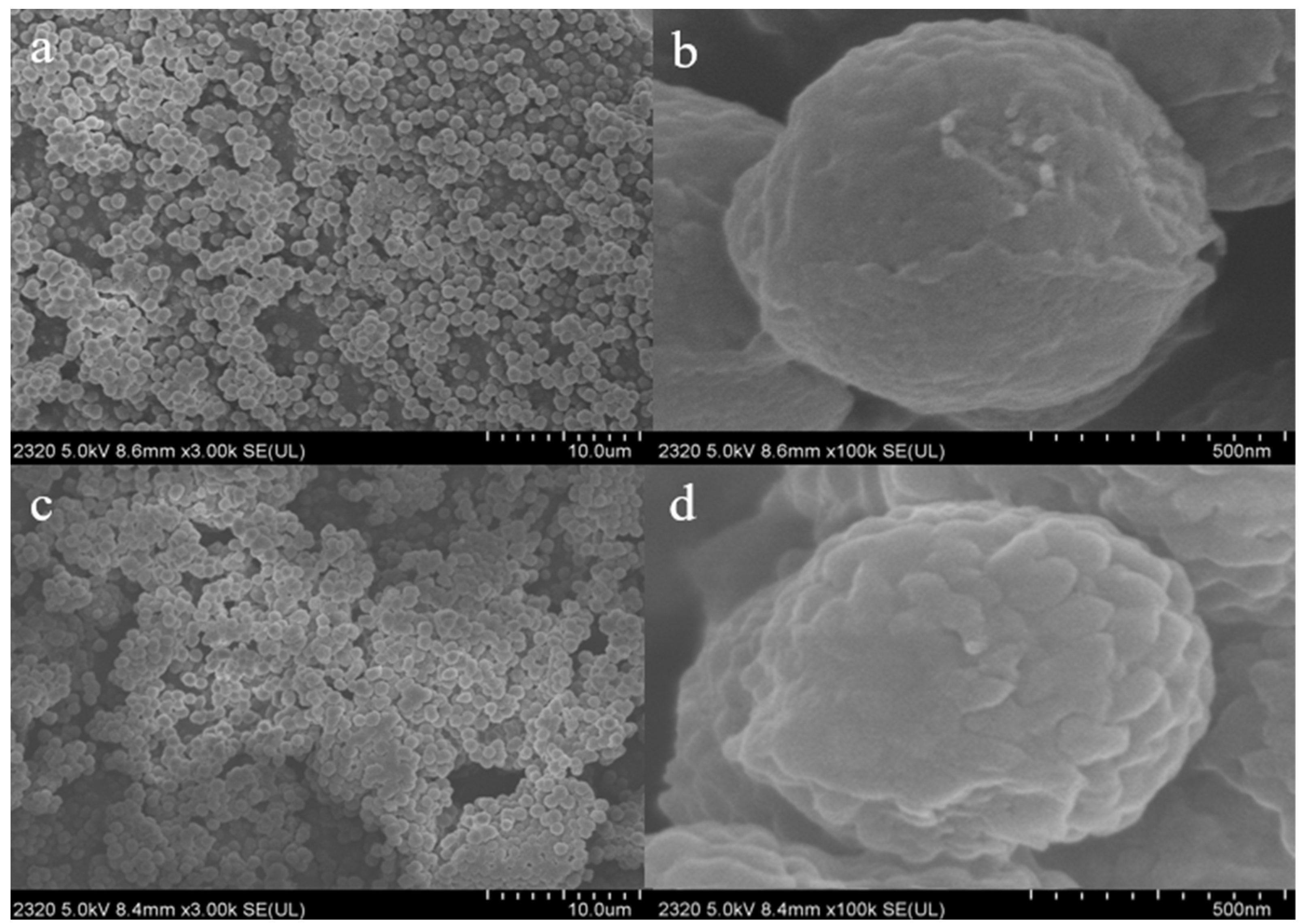
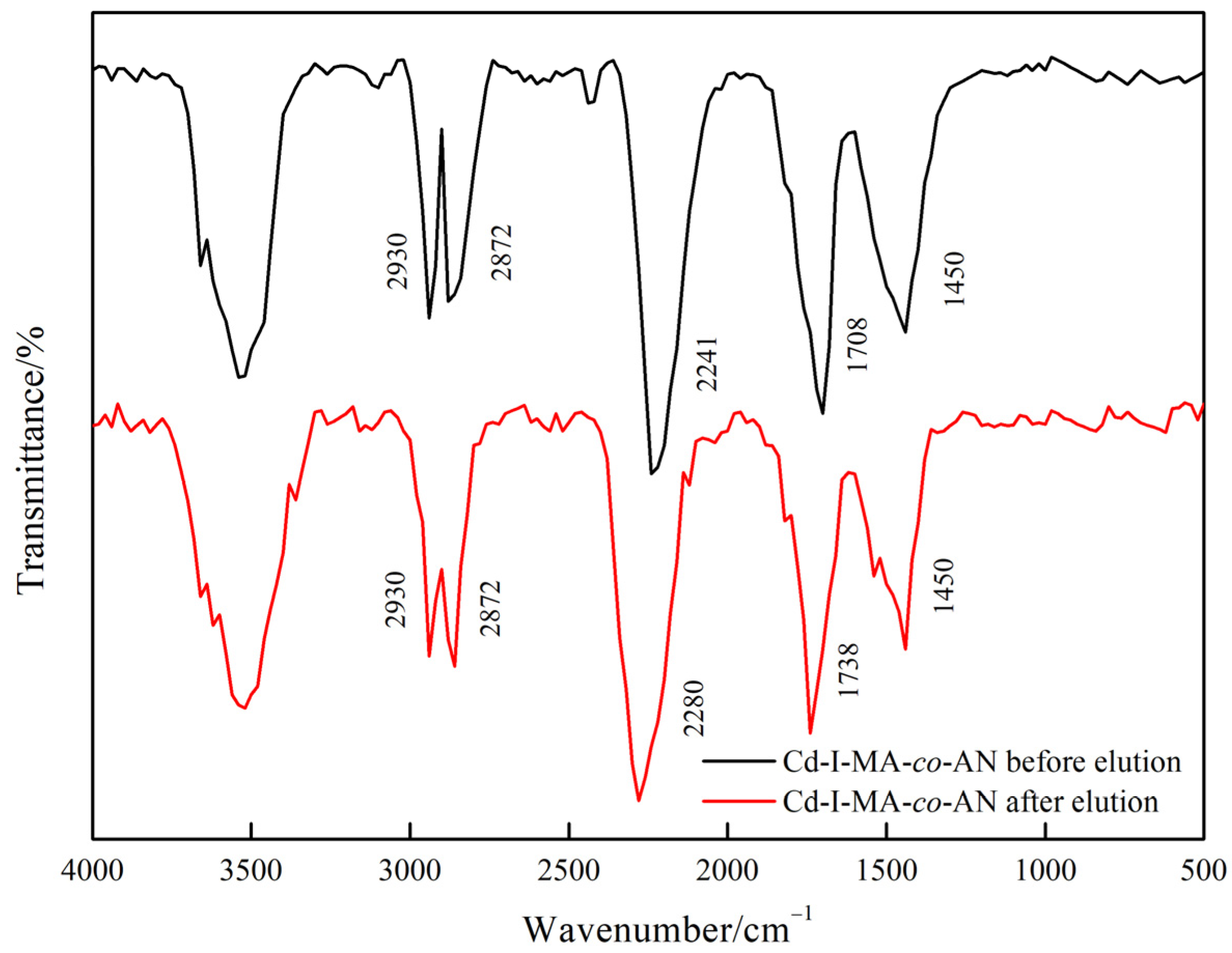
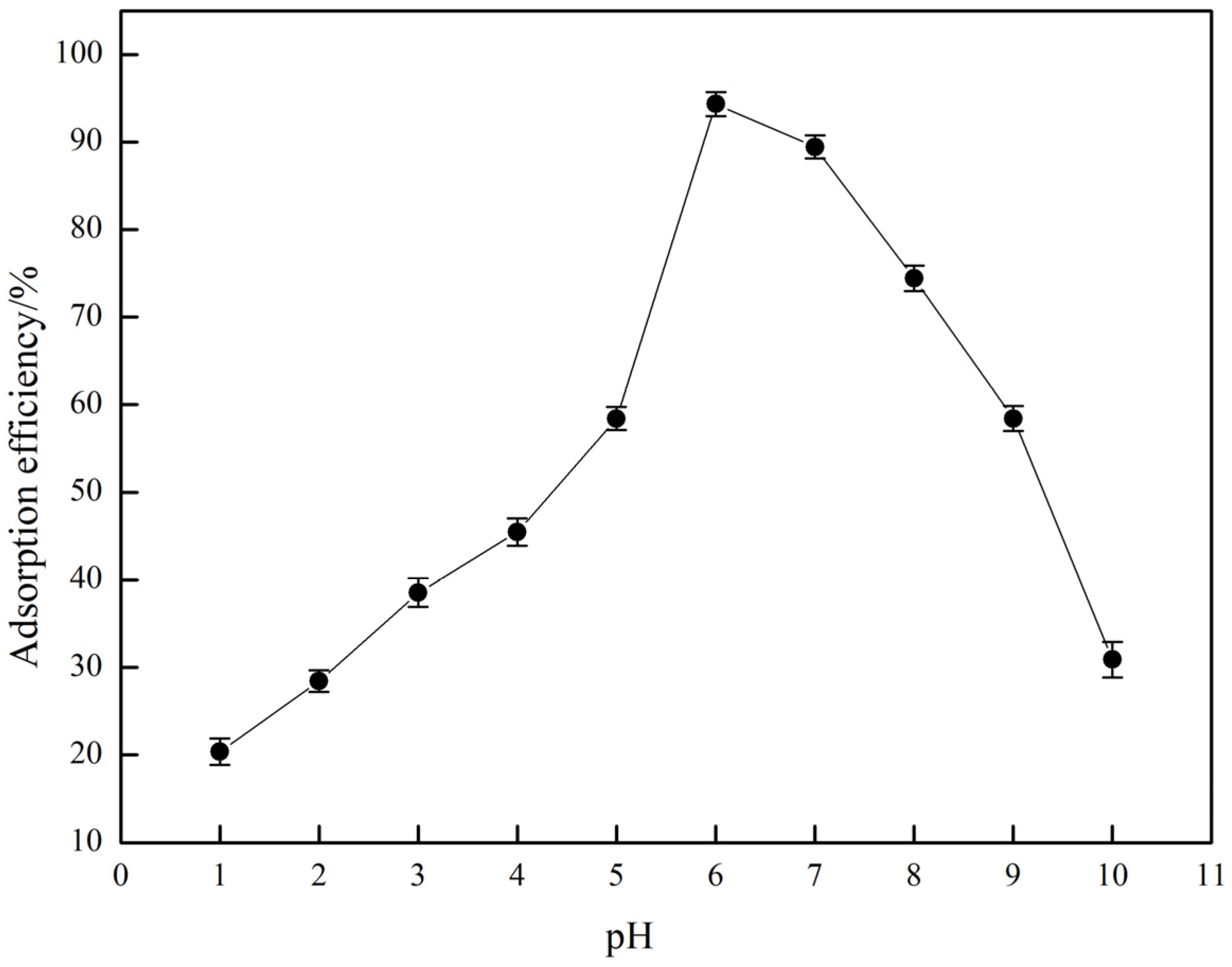
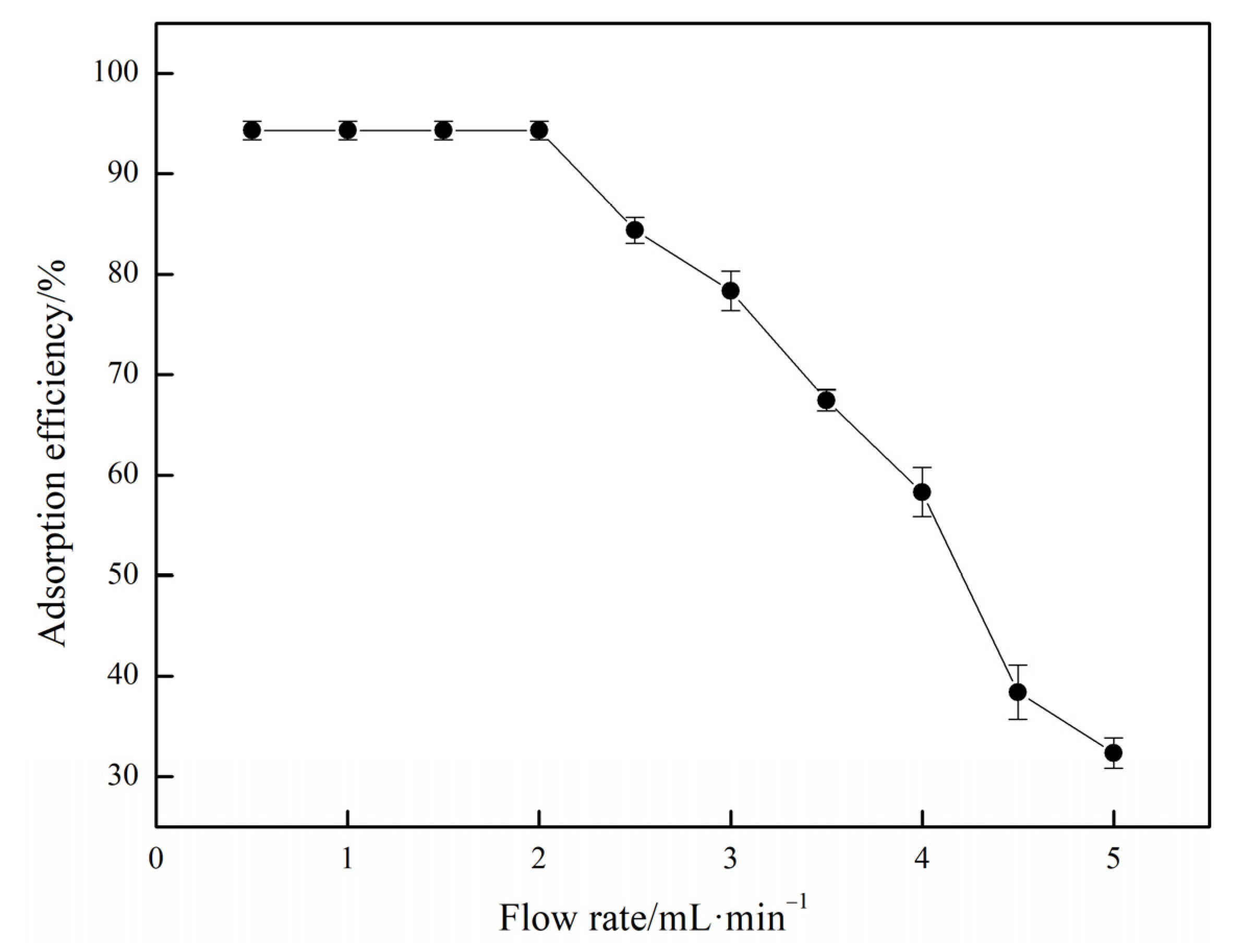


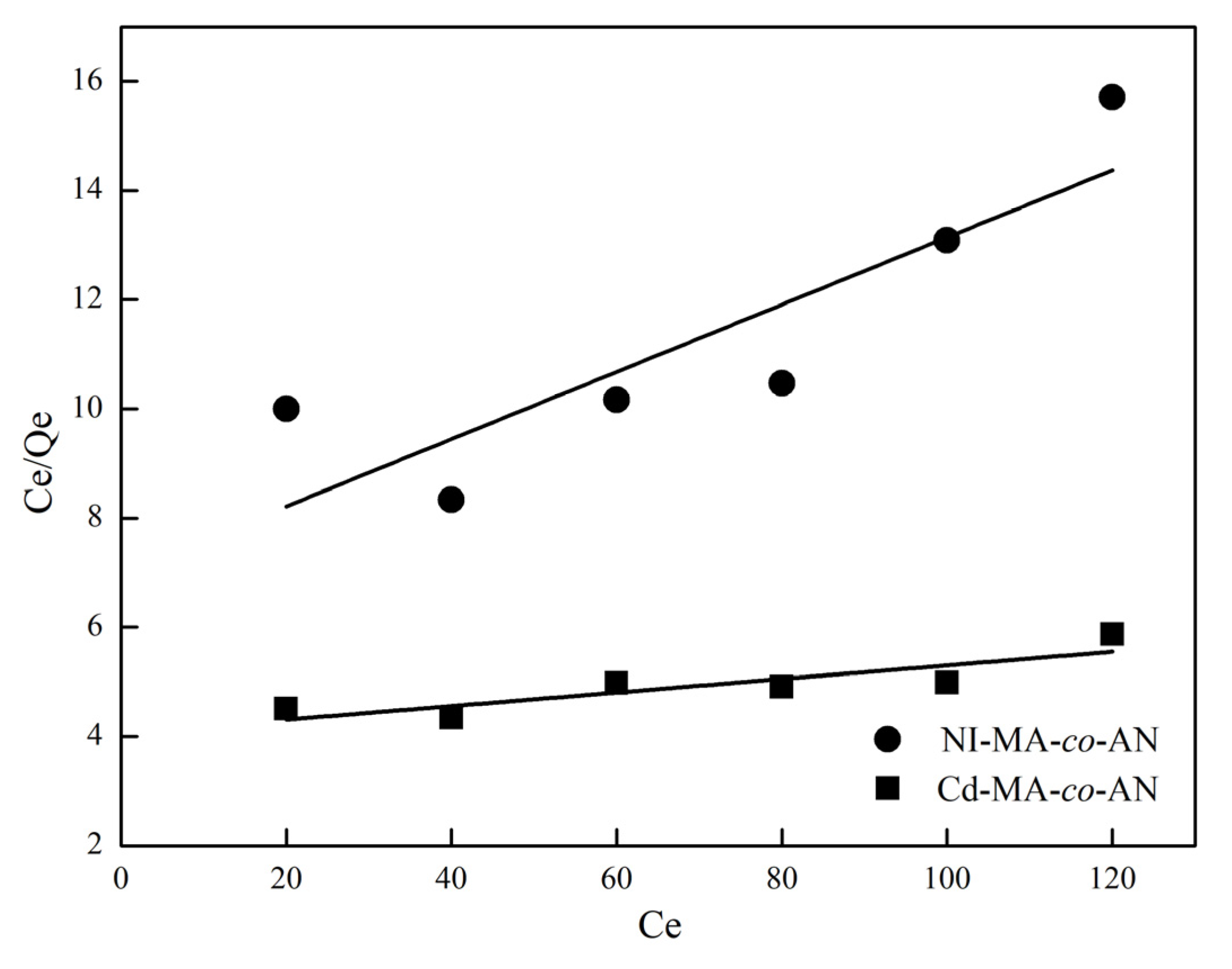


| Adsorbent | Langmuir Isotherm | |
|---|---|---|
| K | R2 | |
| Cd-I-MA-co-AN | 3.732 × 10−3 | 0.7867 |
| NI-MA-co-AN | 8.819 × 10−3 | 0.7567 |
| Adsorbent | Freundlich Isotherm | ||
|---|---|---|---|
| lnKf | R2 | ||
| Cd-I-MA-co-AN | 0.959 | −1.3816 | 0.9564 |
| NI-MA-co-AN | 0.7545 | −1.3983 | 0.9128 |
| Metal Ion | Distribution Coefficient D | Selectivity Coefficient α | Relative Selectivity Coefficient k | ||
|---|---|---|---|---|---|
| Cd-I-MA-co-AN | NI-MA-co-AN | Cd-I-MA-co-AN | NI-MA-co-AN | ||
| Cd(II) | 3.58 | 1.18 | |||
| Cu(II) | 0.236 | 0.294 | 15.2 | 4.01 | 3.79 |
| Mn(II) | 0.873 | 0.975 | 4.10 | 1.21 | 3.39 |
| Ni(II) | 0.389 | 0.500 | 9.20 | 2.36 | 3.90 |
| Pb(II) | 1.19 | 1.30 | 3.01 | 0.908 | 3.31 |
| Sample | Added/μg L−1 | Found/μg L−1 (n = 3, p = 90%) | Recovery/% |
|---|---|---|---|
| Tap water | 0 | - | - |
| 1.00 | 0.98 ± 0.06 | 98.0 | |
| 5.00 | 4.94 ± 0.12 | 98.8 | |
| Spring water | 0 | 0.26 ± 0.09 | - |
| 1.00 | 1.22 ± 0.10 | 96.2 | |
| 5.00 | 5.13 ± 0.13 | 97.4 | |
| River water | 0 | 0.31 ± 0.11 | - |
| 1.00 | 1.29 ± 0.08 | 97.6 | |
| 5.00 | 5.26 ± 0.15 | 98.6 |
| Functional Monomers | Polymerization Techniques | Adsorption Capacity | References |
|---|---|---|---|
| 2-(p-Sulphophenylazo)-1,8-dihydroxy-3,6 naphthalene disulphonic acid trisodium salt | Copolymerization | 270 μg g−1 | [15] |
| Methacrylic acid and vinylimidazole | Bulk polymerization | 3.3 mg g−1 | [40] |
| Acrylonitrile | Aqueous suspension polymerization | 0.018 mg g−1 | [41] |
| 3-Mercaptopropyltrimethoxysilane | Surface imprinting technology | 4.8 mg g−1 | [42] |
| 1-Vinylimidazole | Suspension polymerization | 4.73 mg g−1 | [43] |
| 3-Mercaptopropyltrimethoxysilane | Surface imprinting technique | 5.5025 mg g−1 | [44] |
| 2-Vinylpyridine | Precipitation polymerization | 16.52 mg g−1 | [45] |
| Carboxymethyl chitosan | Surface imprinting technique | 20.7 mg g−1 | [46] |
| Chitosan | Surface imprinting technique | 18.2 mg g−1 | [47] |
| 3-Mercaptopropyltrimethoxysilane | Surface ion imprinting technique | 11.64 mg g−1 | [48] |
| Maleic acid and acrylonitrile | Precipitation polymerization | 20.46 mg g−1 | This work |
Publisher’s Note: MDPI stays neutral with regard to jurisdictional claims in published maps and institutional affiliations. |
© 2022 by the authors. Licensee MDPI, Basel, Switzerland. This article is an open access article distributed under the terms and conditions of the Creative Commons Attribution (CC BY) license (https://creativecommons.org/licenses/by/4.0/).
Share and Cite
Murat, A.; Wang, L.; Abliz, S.; Yimit, A. Preparation, Characterization of Cd(II) Ion-Imprinted Microsphere and Its Selectivity for Template Ion. Coatings 2022, 12, 1038. https://doi.org/10.3390/coatings12081038
Murat A, Wang L, Abliz S, Yimit A. Preparation, Characterization of Cd(II) Ion-Imprinted Microsphere and Its Selectivity for Template Ion. Coatings. 2022; 12(8):1038. https://doi.org/10.3390/coatings12081038
Chicago/Turabian StyleMurat, Aray, Lingling Wang, Shawket Abliz, and Abliz Yimit. 2022. "Preparation, Characterization of Cd(II) Ion-Imprinted Microsphere and Its Selectivity for Template Ion" Coatings 12, no. 8: 1038. https://doi.org/10.3390/coatings12081038
APA StyleMurat, A., Wang, L., Abliz, S., & Yimit, A. (2022). Preparation, Characterization of Cd(II) Ion-Imprinted Microsphere and Its Selectivity for Template Ion. Coatings, 12(8), 1038. https://doi.org/10.3390/coatings12081038






